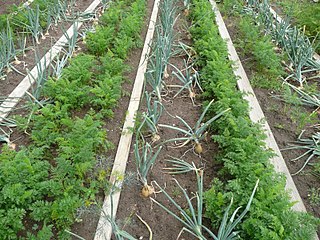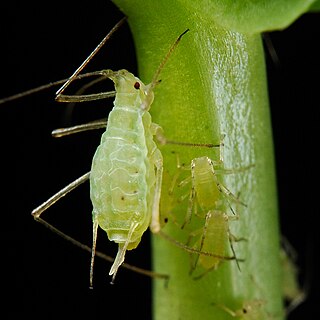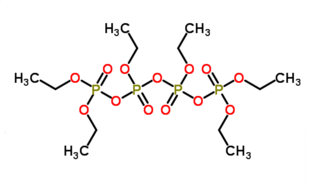
Companion planting in gardening and agriculture is the planting of different crops in proximity for any of a number of different reasons, including pest control, pollination, providing habitat for beneficial insects, maximizing use of space, and to otherwise increase crop productivity. Companion planting is a form of polyculture.

Aphids are small sap-sucking insects and members of the superfamily Aphidoidea. Common names include greenfly and blackfly, although individuals within a species can vary widely in colour. The group includes the fluffy white woolly aphids. A typical life cycle involves flightless females giving living birth to female nymphs—who may also be already pregnant, an adaptation scientists call telescopic development—without the involvement of males. Maturing rapidly, females breed profusely so that the number of these insects multiplies quickly. Winged females may develop later in the season, allowing the insects to colonise new plants. In temperate regions, a phase of sexual reproduction occurs in the autumn, with the insects often overwintering as eggs.

Hoverflies, also called flower flies or syrphid flies, make up the insect family Syrphidae. As their common name suggests, they are often seen hovering or nectaring at flowers; the adults of many species feed mainly on nectar and pollen, while the larvae (maggots) eat a wide range of foods. In some species, the larvae are saprotrophs, eating decaying plant and animal matter in the soil or in ponds and streams. In other species, the larvae are insectivores and prey on aphids, thrips, and other plant-sucking insects.

The Hemiptera or true bugs are an order of insects comprising some 50,000 to 80,000 species of groups such as the cicadas, aphids, planthoppers, leafhoppers, bed bugs and shield bugs. They range in size from 1 mm (0.04 in) to around 15 cm (6 in), and share a common arrangement of sucking mouthparts. The name "true bugs" is often limited to the suborder Heteroptera. Many insects commonly known as "bugs", especially in American English, belong to other orders; for example, the lovebug is a fly and the May bug and ladybug are beetles.

Galls or cecidia are a kind of swelling growth on the external tissues of plants, fungi, or animals. Plant galls are abnormal outgrowths of plant tissues, similar to benign tumors or warts in animals. They can be caused by various parasites, from viruses, fungi and bacteria, to other plants, insects and mites. Plant galls are often highly organized structures so that the cause of the gall can often be determined without the actual agent being identified. This applies particularly to some insect and mite plant galls. The study of plant galls is known as cecidology.
The MolniyaR-60 is a short-range lightweight infrared homing air-to-air missile designed for use by Soviet fighter aircraft. It has been widely exported, and remains in service with the CIS and many other nations.

The Aphididae are a very large insect family in the aphid superfamily (Aphidoidea), of the order Hemiptera. Several thousand species are placed in this family, many of which are well known for being serious plant pests. They are also the family of insects containing most plant virus vectors with the green peach aphid being one of the most prevalent and indiscriminate carriers.

The term farnesene refers to a set of six closely related chemical compounds which all are sesquiterpenes. α-Farnesene and β-farnesene are isomers, differing by the location of one double bond. α-Farnesene is 3,7,11-trimethyl-1,3,6,10-dodecatetraene and β-farnesene is 7,11-dimethyl-3-methylene-1,6,10-dodecatriene. The alpha form can exist as four stereoisomers that differ about the geometry of two of its three internal double bonds. The beta isomer exists as two stereoisomers about the geometry of its central double bond.

The Sternorrhyncha suborder of the Hemiptera contains the aphids, whiteflies, and scale insects, groups which were traditionally included in the order Homoptera. "Sternorrhyncha" refers to the rearward position of the mouthparts relative to the head.
Citrus tristeza virus (CTV) is a viral species of the genus Closterovirus that causes the most economically damaging disease to its namesake plant genus, Citrus. The disease has led to the death of millions of Citrus trees all over the world and has rendered millions of others useless for production. Farmers in Brazil and other South American countries gave it the name "tristeza", meaning sadness in Portuguese and Spanish, referring to the devastation produced by the disease in the 1930s. The virus is transmitted most efficiently by the brown citrus aphid.

The Phylloxeroidea is a small superfamily of the Hemiptera within the infraorder Aphidomorpha which is closely related to the aphids which are traditionally included in the Aphidoidea, which is the sister taxon. The two extant families are the pine and spruce aphids and the phylloxerans (Phylloxeridae), including vine phylloxera, a serious pest of grapevines.

The Adelgidae are a small family of the Hemiptera closely related to the aphids, and often included in the Aphidoidea with the Phylloxeridae or placed within the superfamily Phylloxeroidea as a sister of the Aphidoidea within the infraorder Aphidomorpha. The family is composed of species associated with pine, spruce, or other conifers, known respectively as "pine aphids" or "spruce aphids". This family includes the former family Chermesidae, or "Chermidae", the name of which was declared invalid by the ICZN in 1955. There is still considerable debate as to the number of genera within the family, and the classification is still unstable and inconsistent among competing authors.

The soybean aphid is an insect pest of soybean that is exotic to North America. The soybean aphid is native to Asia. It has been described as a common pest of soybeans in China and as an occasional pest of soybeans in Indonesia, Japan, Korea, Malaysia, the Philippines, and Thailand. The soybean aphid was first documented in North America in Wisconsin in July 2000. Ragsdale et al. (2004) noted that the soybean aphid probably arrived in North America earlier than 2000, but remained undetected for a period of time. Venette and Ragsdale (2004) suggested that Japan probably served as the point of origin for the soybean aphid's North American invasion. By 2003, the soybean aphid had been documented in Delaware, Georgia, Illinois, Indiana, Iowa, Kansas, Kentucky, Michigan, Minnesota, Mississippi, Missouri, Nebraska, New York, North Dakota, Ohio, Pennsylvania, South Dakota, Virginia, West Virginia, and Wisconsin. Together, these states accounted for 89% of the 63,600,000 acres (257,000 km2) of soybean planted in the United States in 2007.

Aphis is a genus of insects in the family Aphididae containing at least 600 species of aphids. It includes many notorious agricultural pests, such as the soybean aphid Aphis glycines. Many species of Aphis, such as A. coreopsidis and A. fabae, are myrmecophiles, forming close associations with ants.

Myzus persicae, known as the green peach aphid, greenfly, or the peach-potato aphid, is a small green aphid. It is the most significant aphid pest of peach trees, causing decreased growth, shrivelling of the leaves and the death of various tissues. It is also acts as a vector for the transport of plant viruses such as cucumber mosaic virus (CMV), potato virus Y (PVY) and tobacco etch virus (TEV). Potato virus Y and potato leafroll virus can be passed to members of the nightshade/potato family (Solanaceae), and various mosaic viruses to many other food crops.

The black bean aphid is a small black insect in the genus Aphis, with a broad, soft body, a member of the order Hemiptera. Other common names include blackfly, bean aphid, and beet leaf aphid. In the warmer months of the year, it is found in large numbers on the undersides of leaves and on the growing tips of host plants, including various agricultural crops and many wild and ornamental plants. Both winged and wingless forms exist, and at this time of year, they are all females. They suck sap from stems and leaves and cause distortion of the shoots, stunted plants, reduced yield, and spoiled crops. This aphid also acts as a vector for viruses that cause plant disease, and the honeydew it secretes may encourage the growth of sooty mould. It breeds profusely by live birth, but its numbers are kept in check, especially in the later part of the summer, by various predatory and parasitic insects. Ants feed on the honeydew it produces, and take active steps to remove the aphid's enemies. It is a widely distributed pest of agricultural crops and can be controlled by chemical or biological means. In the autumn, winged forms move to different host plants, where both males and females are produced. These mate and the females lay eggs which overwinter.

Acyrthosiphon pisum, commonly known as the pea aphid, is a sap-sucking insect in the family Aphididae. It feeds on several species of legumes worldwide, including forage crops, such as pea, clover, alfalfa, and broad bean, and ranks among the aphid species of major agronomical importance. The pea aphid is a model organism for biological study whose genome has been sequenced and annotated.

Phylloxeridae is a small family of plant-parasitic hemipterans closely related to aphids with only 75 described species. This group comprises two subfamilies and 11 genera with one that is fossil. The genus type is Phylloxera. The Phylloxeridae species are usually called Phylloxerans or Phylloxerids.

Hexaethyl tetraphosphate (also known as HET) is the organophosphorus compound with the chemical formula [(C2H5O)3P2O3]2O. The compound has not been isolated in pure form but appears to be a colorless liquid at room temperature. Commercial samples appear brown due to impurities. It is a constituent of the insecticide Bladan. In the 1940s, it was about as significant an insecticide as DDT and was referred to as "another of DDT's rivals for fame" in a 1948 book.













